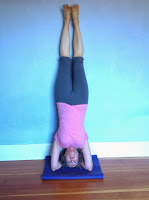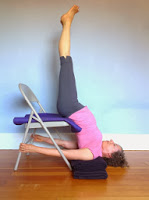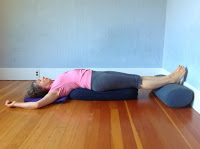by Nina
It’s no secret that I’m a huge fan of supported inverted yoga poses. I starting raving about them in the early days of Yoga for Healthy Aging in my post Just In Time for the Holidays: Inverted Poses, going on and on about how these poses are so beneficial for stress management (and also for circulation). Later on, I wrote in detail about why—from a scientific perspective—these posts are so effective at reducing stress in my post Why You Should Love Your Baroreceptors.
But if you’re newer to yoga or can’t do the classic inverted poses, Headstand and Shoulderstand (or just can’t get comfortable in them), you might be wondering: how does all this apply to you? Well, I’m here today to assure you that with certain exceptions due to medical conditions (see Cautions for Inversions), everyone can do at least some of the supported inverted yoga poses. That’s because in yoga an inverted pose is any pose where your heart is higher than your head. So in addition to “full” inversions such as Headstand and Shoulderstand, there are several “partial” inversions that are very accessible. And partial inversions are as effective at stress reduction as full inversions (maybe even more so, as some are comfortable enough to stay in for long periods of time). I find the relaxation achieved with these poses more refreshing than that from restorative poses (though obviously some people prefer those).
Today I thought I’d give an overview of the complete set of inverted poses, with their pros and cons, so you could see which ones look most promising to you. I’ve gone ahead and divided them into three categories (can you tell I used to be a technical writer?): Half Inversions, Full Inversions, and Gentle Inversions.
Half Inversions. In a half inversion, your heart and pelvis are above your head, but your feet are below your heart. This category includes: Standing Forward Bend (Uttanasana), Widespread Standing Forward Bend (Prasarita Padottanasana), Downward-Facing Dog, all with head support.These three poses are very accessible ones because you can use props of any height you need. But because they are standing poses, it is not possible to hold these poses for extended periods of time. Although soothing on their own (especially the Supported Standing Forward Bend), if you just have a couple of minutes they are good warm-ups for full inversions or gentle inversions because they stretch the backs of your legs and open your shoulders and hips.

Downward-Facing Dog is a surprisingly soothing pose when you use support for your head. But you must use a prop that is high enough (try a bolster) and be careful to place the prop in the right position (below where your head naturally falls in the pose, and not so you need to move forward—or bend your arms—to rest your forehead on the prop). If your shoulders and/or hamstrings are very tight, this pose can be physically demanding and not quieting. However, it’s still a great warm up pose for other inversions, as it opens your hips, legs, and shoulders while getting you used to being partly upside down.
 Standing Forward Bend is surprisingly quieting if you find a prop that is high enough so you can do the pose without feeling an uncomfortable stretch in your hamstrings. Be honest with yourself and use a chair if necessary (or even if it’s not). However, if you are very tight and can’t bend your body to 90 degrees in a seated forward bend, you may not be able to get comfortable in this pose.
Standing Forward Bend is surprisingly quieting if you find a prop that is high enough so you can do the pose without feeling an uncomfortable stretch in your hamstrings. Be honest with yourself and use a chair if necessary (or even if it’s not). However, if you are very tight and can’t bend your body to 90 degrees in a seated forward bend, you may not be able to get comfortable in this pose.

Widespread Standing Forward Bend feels more grounding than quieting to me because it’s so demanding on the hips and legs. But for people whose hips are more open than their hamstrings, this may be more accessible than Standing Forward Bend. Be honest with yourself and use a chair if necessary (or even if it’s not).
Full Inversions. In a full inversion your heart is higher than your head, and your pelvis, legs and feet are higher that your heart. The full inversions include: Headstand, Shoulderstand and Plow pose, with supported versions of all three. (Technically I suppose you could call most of the arm balances, such as Handstand and Peacock Tail Feather pose, inversions but because they are so strenuous, they don’t really qualify as quieting poses.)
Because these poses are fully inverted, they are rapidly effective. For this reason, I feel it is worth taking the time to learn them (with guidance from an experienced teacher). But these are also the most physically demanding of the inverted poses, so if you’re not comfortable while doing them them, the stress factor in doing them counteracts any calming effects they might have. It’s good to warm up for these poses, either by doing leg stretches and hip and shoulder openers and/or by doing the partial inversions described above.

Headstand is a very grounding pose as the combination of the inversion with the focus it takes to balance helps move you into the present moment. However, Headstand puts a lot of pressure on your neck so if your neck is a problem area for you, it’s best to avoid it. I love Headstand but it is clearly not for everyone.

Shoulderstand is special because you are both supported and fully inverted, so the relaxation response will take effect quite quickly. Your neck is also flexed in the pose, which enhance the relaxation (see More Love for Baroreceptors). And you can use the supported version of Shoulderstand in place of full Shoulderstand in any sequence (or class) that includes full Shoulderstand. However, the pose is tricky to get into and can make beginners feel insecure. And it’s not comfortable for everyone. See Chair Shoulderstand for instructions.

Plow pose is a very quieting pose, but only if you can get comfortable in it. It can be quite physically challenging for stiff people. And if your neck is stiff and can’t bend deeply, this pose might not be for you. Also people with round bodies sometimes find this a difficult—if not impossible—pose to get into. See Supported Plow Pose for instructions.
Gentle Inversions. Gentle inversions are more gradual poses than the straight up and down inversions of heart directly over the head in partial and full inversions. In these poses, although your heart is higher than your head, it is only slightly higher (though even this small differential is enough to trigger the relaxation response). But because these poses are more gradual inversions, they are accessible to almost everyone. In fact, I can almost guarantee you will fall in the love with at least one of them. These poses include: Easy Inverted Pose, Straight Leg Bridge pose (Setubandasana), and Legs Up the Wall pose (Viparita Karani), all with support.
You don’t need to warm up for these poses, but for some people, they may be more comfortable if you do. They can come at the end of any practice, either a restorative or inversion practice, or any active practice as well. Or they could be a practice in and of themselves.
The advantage of these poses is that they are very comfortable for most people and you can stay in them for quite a while. I find that after seven or eight minutes, I can actually feel the relaxation response kick in, as a kind of “quiet switch.” Then I stay for a while longer to reap some of the benefits of full conscious relaxation (see Conscious Relaxation vs. Sleep).

Straight Leg Bridge pose is special because (if this pose is comfortable for you) you can stay in this pose for a very long period of time. I once heard Roger Cole, senior teacher and sleep researcher, say that Straight Leg Bridge pose was his go-to relaxation pose and that he’d stay in it up to 45 minutes! People with lower back problems sometimes have a hard time getting comfortable in Straight Leg Bridge pose, but lowering the propping (by using two folded blankets instead of a bolster under the back) can help. And if I just can’t find a way to help the student be comfortable in this pose, I encourage them to set up in Easy Inverted pose instead. Instructions for Straight Leg Bridge pose are coming soon!

Legs Up the Wall pose has a very dramatic quieting effect because your legs are inverted in this pose. I notice the relaxation response kicking in after about seven or eight minutes. However, I’ve observed that people with very tight hamstrings have trouble getting comfortable in Legs Up the Wall pose. It is possible to do the pose slightly further from the wall, with a bolster in a vertical position supporting your legs. But if I just can’t find a way to help the student be comfortable, I encourage them to set up in Easy Inverted pose instead. Most people can stay in this pose for twenty minutes, but after that many people find their legs fall asleep. See Legs Up the Wall Pose for instructions.

Easy Inverted pose is is an amazing pose! Because your legs are inverted as well as your heart, the pose is very quieting. And I’ve never been unable to help a student be comfortable in this pose! If two folded blankets is irritating to your lower back, try just one and make sure your tailbone and buttocks are fully supported by the blanket (and are not tilting into a backbend). Having the support under your pelvis is what makes your heart slightly higher than your head, so see if you can find a way to make it work. See Easy Inverted Pose for information.
Follow Yoga for Healthy Aging on Facebook ° To order Yoga for Healthy Aging: A Guide to Lifelong Well-Being, go to Amazon, Shambhala, Indie Bound or your local bookstore.


Ahh, these are nice. Thank you for all the inversions. If feel a bit crinkly in my chest because of the pacemaker and it's wires, so now I can just use my props and not have to feel this way!
Fantastic information as always! Sharing with my Yoga for Pacemakers/ICD group!